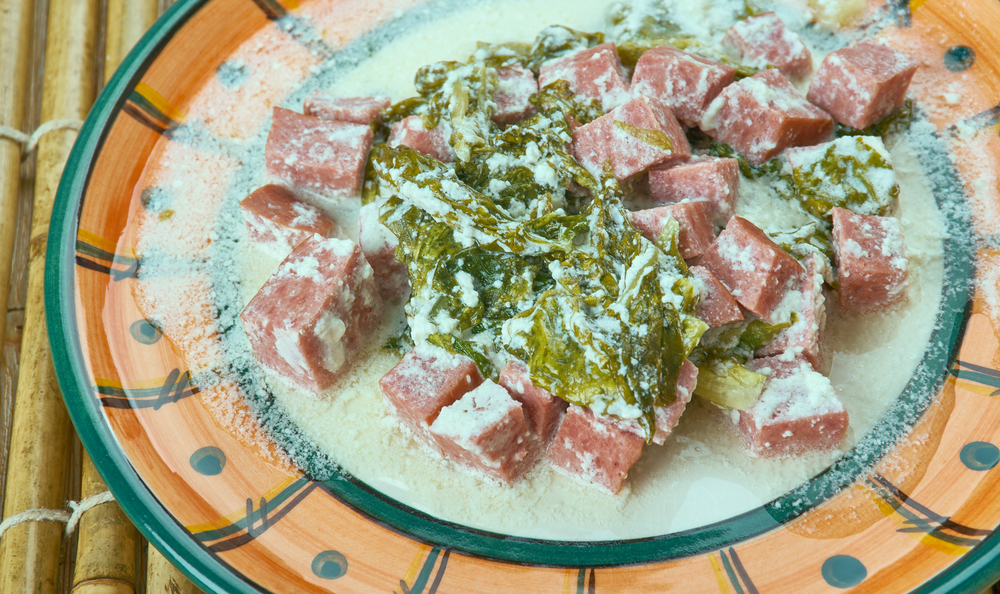Palusami, an unassuming yet profoundly flavorful dish, stands as a testament to Samoa’s rich culinary heritage. It’s a symphony of taro leaves drenched in luscious coconut milk, often enjoyed during feasts and everyday meals alike.
Palusami and Samoan Ceremonial Events
Central to Samoan festivities and family gatherings, Palusami holds a revered spot in ceremonial banquets. Be it weddings, title ceremonies, or village fono (council meetings), the presence of Palusami is a nod to tradition, respect, and communal bonds.
The Oceanic Bounty: Celebrated in a Dish
Samoa, with its fertile volcanic soil and bounteous seas, yields a plethora of fresh produce. Palusami encapsulates this natural wealth, utilizing taro leaves and coconuts, both of which are staples in the Samoan diet and agricultural practices.
Key Ingredients and Variations
- Taro leaves (Lu’au) – 10-12 large leaves
- Coconut milk – 400 ml
- Onions – 1, finely chopped (optional)
- Salt – to taste
Variations:
– Some versions might include tinned corned beef (pisupo) or fresh fish.
– Chopped tomatoes or bell peppers can add color and taste variations.
Preparation Steps and Cooking Nuances
- Prepping Taro Leaves: Clean the taro leaves thoroughly and remove any tough stems.
- Layering Ingredients: On a flat surface, place 2-3 taro leaves. If adding onions, place them on the leaves. Pour a generous amount of coconut milk and season with salt.
- Wrapping: Fold the taro leaves to encase the coconut milk, forming a parcel. Repeat the process with the remaining leaves and filling.
- Cooking: Traditionally, Palusami is cooked in an ‘umu’ (earth oven). However, in modern settings, you can place the wrapped parcels in an oven-safe dish and bake at 180°C for about 45 minutes to an hour, until the taro leaves are tender and the coconut milk has thickened.
- Serving: Carefully open the parcels and serve the creamy Palusami with steamed rice or root vegetables.
Cooking Nuances:
– For an enriched flavor, some households let the coconut milk simmer with onions before using it in Palusami.
– The taro leaves should be thoroughly cooked to eliminate any potential itchiness when consumed.

The Global Journey of Palusami
While quintessentially Samoan, Palusami’s appeal has crossed oceans. Many Pacific Island communities have adopted and adapted it, and with the Samoan diaspora, it has found a place in kitchens worldwide. This global journey is a testament to Palusami’s delightful taste and the universal love for comfort food.
Concluding Observations
Palusami, with its minimalistic ingredients and preparation, shines a spotlight on the beauty of Samoan cuisine – uncomplicated, natural, yet bursting with flavor. As you savor its creamy goodness, you’re not just enjoying a dish but partaking in Samoa’s age-old traditions and communal spirit.
Frequently Asked Questions (FAQs)
- Is there a vegetarian version of Palusami?
- The basic Palusami with taro leaves and coconut milk is inherently vegetarian. It’s the addition of meat or fish that introduces non-vegetarian elements.
- How long can I store Palusami?
- Palusami is best consumed fresh. However, if you have leftovers, refrigerate them in an airtight container for up to two days. Reheat thoroughly before serving.
- Can I use spinach if taro leaves are unavailable?
- While taro leaves are traditional, spinach can serve as a substitute. However, the flavor and texture might slightly differ.
Palusami is a testament to Samoa’s rich culinary traditions. Discover more island delights in our Oceania culinary journey.
